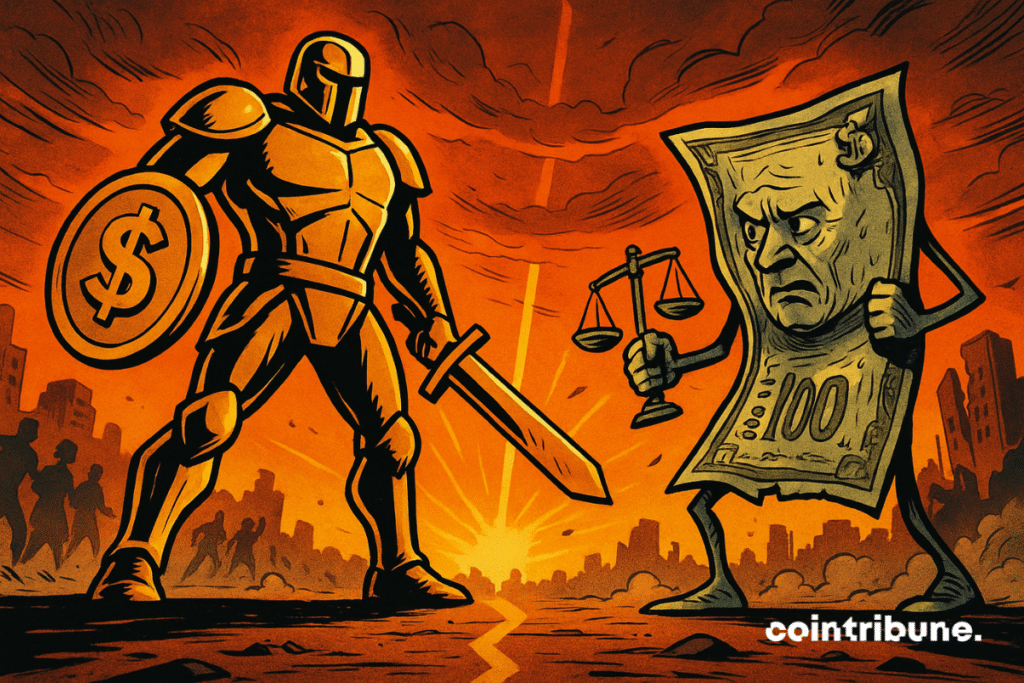Foreign Central Banks now own more Gold than U.S. Treasuries for the first time in almost 30 years 🚨🚨🚨 pic.twitter.com/7wLTCux1mu
— Barchart (@Barchart) October 26, 2025
A
A
Central Banks Dump Treasuries In Favor Of Gold
Mon 27 Oct 2025 ▪
5
min read ▪ by
Getting informed
▪
Trading
Summarize this article with:
A discreet but historic shift has occurred in central bank reserves. For the first time in nearly 30 years, gold surpasses U.S. Treasury bonds. This adjustment, far from trivial, reflects a growing loss of confidence in U.S. sovereign debt. Behind this choice, central banks are reshaping their priorities, betting on the timeless strength of the yellow metal. This signal, almost unnoticed, could redefine the foundations of the global monetary system.

In Brief
- Foreign central banks now hold more gold than U.S. Treasury bonds, a first in nearly 30 years.
- This transition results from a gradual loss of confidence in U.S. sovereign debt, fueled by rising rates and exploding public debt.
- Massive gold purchases in 2025, estimated at 900 tonnes, confirm an accelerated diversification strategy.
- Gold establishes itself as a renewed safe haven asset, considered pristine collateral amid the dollar’s erosion as monetary foundation.
A Historic Turning Point in Central Bank Strategy
While tokenized gold surpasses the billion-dollar daily volume threshold, a data point surprised even the most seasoned analysts this October. Foreign central banks now hold more gold than U.S. Treasury bonds, a situation unprecedented since the mid-1990s.
The chart published by Barchart on October 26 confirms this symbolic but highly significant reversal. It represents a discreet yet fundamental break in reserve logic.
This shift is based on a particularly sustained gold buying dynamic over several years, which intensified throughout this year. Here are the main figures provided by the World Gold Council :
- 19 net tonnes bought in August 2025, after 10 tonnes in July ;
- An annual pace projecting approximately 900 tonnes of purchases in 2025, double the historical average ;
- The fourth consecutive year where purchases far exceed usual standards ;
- A trend started in 2010 : central banks have been net buyers of gold for 16 consecutive years ;
- In just six months, 23 countries have increased their gold reserves.
In other words, this is not an isolated peak or a short-term tactical repositioning. It’s a deliberate, coordinated, and sustainable strategy reflecting a redefinition of gold’s role as a trust anchor in an increasingly uncertain macroeconomic context.
A Structural Shift in Monetary Confidence
Behind these accounting decisions lie deeper geopolitical and strategic choices. Macro-analyst Sunil Reddy speaks of a paradigm shift : “when these balances nearly vanished, gold skyrocketed… Capital seeks what cannot fail: strong currency. Gold is no longer just inflation protection; it becomes precious collateral, the asset of last trust.”
For him, the recent gold rise does not simply stem from an inflationary environment but from a sharp drying up of secure liquidity once embodied by Treasury bonds.
At the same time, this shift to hard assets does not go unnoticed in the crypto ecosystem. Investor and crypto analyst Lark Davis highlighted an intriguing correlation. While gold experienced a 5 % drop, its worst day since 2013, bitcoin gained 3 %.
According to him, “If BTC captures even a fraction of gold’s market cap, it could mark the start of an insane rally… 1 % equals $134,000, 3 % $188,000.”
Mister Crypto echoes this: “digital gold is next.” Even though the brutal gold selloff seems to have been triggered by technical mechanisms, a massive sale of ETFs triggering automatic orders, Chinese institutional investors have continued to increase their exposure. No structural withdrawal signs appear on the physical gold side.
This shift of institutional capital toward assets considered “non-failing” could well redefine the axes of trust on which the global monetary system relies. Gold regains its status as a tangible anchor in a liquid and over-indebted world. However, while central banks reaffirm their preference for gold, individuals may soon turn to its digital equivalent. Bitcoin, still on the sidelines of these macroeconomic arbitrages, may be waiting for its moment. Far from being a mere speculative asset, it could become, for a growing portion of investors, the ultimate asset of decentralized trust that will join gold in central banks’ balance sheets.
Maximize your Cointribune experience with our "Read to Earn" program! For every article you read, earn points and access exclusive rewards. Sign up now and start earning benefits.
A
A
Diplômé de Sciences Po Toulouse et titulaire d'une certification consultant blockchain délivrée par Alyra, j'ai rejoint l'aventure Cointribune en 2019. Convaincu du potentiel de la blockchain pour transformer de nombreux secteurs de l'économie, j'ai pris l'engagement de sensibiliser et d'informer le grand public sur cet écosystème en constante évolution. Mon objectif est de permettre à chacun de mieux comprendre la blockchain et de saisir les opportunités qu'elle offre. Je m'efforce chaque jour de fournir une analyse objective de l'actualité, de décrypter les tendances du marché, de relayer les dernières innovations technologiques et de mettre en perspective les enjeux économiques et sociétaux de cette révolution en marche.
DISCLAIMER
The views, thoughts, and opinions expressed in this article belong solely to the author, and should not be taken as investment advice. Do your own research before taking any investment decisions.